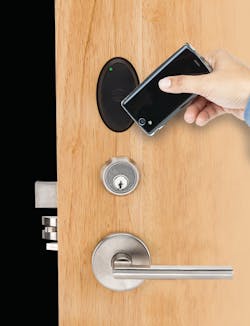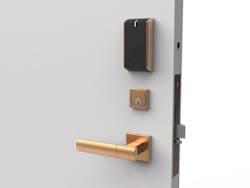Electronic security has evolved, so your approach to troubleshooting also must change.
Many security devices today are battery-powered and wireless, composed of sealed modules and assemblies. So, although they’re “electronic,” they aren’t based on the conventional component architectures that were used predominantly only a few short years ago. Component architectures still are in use but not as much on stand-alone devices, such as door locks and exit alarms.
If you ever looked “under the hood,” electronic products were printed circuit boards that had discrete components soldered onto them and werehard-wired to other subassemblies — resistors, transistors, capacitors and diodes.
Integrated circuits then joined the topology. These are composed of thousands of components sealed inside a single body. This permitted further miniaturization of devices. Also, surface-mounted devices (SMDs) came into use, where the component rested on the circuit board and was soldered into place.
After electronic products were built around integrated circuits and SMDs, troubleshooting went from the component level to the module level. The result is, these days, many devices aren’t designed to be repaired, but, rather, diagnosed, and then modules, subassemblies or the whole thing is replaced. Either they contain no user-accessible parts, they’re so inexpensive that servicing isn’t cost-effective, or time is of the essence and the door has to be returned to service as soon as possible.
I used to say that the most important tool with respect to troubleshooting electronic security systems was the multimeter, but now I’ve added another essential item — your thinking cap.
Safety First
The safety and security of the building occupants come first, so you have to deal with the problem in the fastest way possible.
In many instances, it’s impractical to remove hardware from a door, because it will affect the security or safety of the door and the building if it were to be removed. This is where having service spares is an advantage.
Next is your and your crew’s safety. Dangers present include electrical power that might cause a shock and site conditions that can include machinery and equipment, as well as building occupants who are potentially dangerous to themselves and others.
There’s the danger of falling off a ladder, particularly if someone bumps into it, or even being hit by a moving vehicle or object.
None of this addresses the potential dangers that malfunctioning lock and security equipment might pose: preventing egress, creating obstructions and causing confusion and panic. Loss of security could result in unauthorized entry into the protected area, which creates a whole plethora of potential threats and problems — and potential liabilities for you.
Diagnosing the Problem
Component electronic systems often are separate assemblies that can be dealt with individually and for which troubleshooting can be performed.
Often troubleshooting will point to problems with:
- Power to the malfunctioning equipment
- Failure of the logic or controller to perform its intended function
- Failure of the locking equipment to lock or unlock
Other reasons systems won’t work are because of the environment in which they’re installed or user error.
Let’s discuss power. Power typically begins with line voltage, which is presented by a receptacle or from a breaker panel. You first must verify power is present. Good starting points are a receptacle tester or a voltage probe.
My heart sinks when I find wiring errors in a receptacle, because it’s a harbinger of other problems that I’m likely to encounter if someone couldn’t even wire a receptacle properly. If you find this, you should alert the property owner or manager immediately before proceeding, because miswires can cause malfunctions and hazards. You have to have these resolved first by someone licensed and authorized to work on the facility’s electrical system.
An inductive probe detects the presence or absence of electrical power without your having to make physical contact with electrical conductors.
I’ve found pencil-size voltage detectors to be great while you familiarize yourself with the equipment you service and determine the exact nature of the malfunction. They can detect voltage through the insulation on the wire, and they’re made of nonconductive material, so the tip can be placed safely on exposed terminals and wire conductors.
After you determine that the equipment receives line voltage, then you can verify the system’s power supply is stepping down the line voltage into the required voltage operating range. For electronic security and access control, this typically will be 12 or 24 volts, either AC (alternating current) or DC (direct current). You might not be able to detect measure voltages properly unless you set your tester to the correct range. Some detectors ignore AC when they’re set to detect DC and vice versa.
Making more-precise voltage measurements, as well as current and conductivity (resistance), require a test meter.
Meters are available at many prices. How much you spend has to do with what you require of your meter, how much you can afford and whether you’re subject to peer pressure. For many years, test meters used analog displays that were accurate, fragile and expensive. Digital meters tend to be less fragile and less expensive. After a few of my analog meters fell off ladders (and broke) or were stolen, I started to use digital meters.
These days most meters are built on microchips (another name for an integrated circuit) and are accurate even if the meter cases in which they’re installed aren’t rugged. The better meters can be bench-calibrated and are designed with quality insulated shockproof cases and accessories that make them safe to use.
So, which is a better deal, a $50 meter every few months or one for a few bucks more that you use for several decades? In all fairness, I’ve had a few expensive meters fail and become nonrepairable, and I also own a backup meter that cost under $10.
Fixing the Problem
If there’s no output from your power supply and it’s receiving voltage, momentarily disconnect the load (lock, controller, keypad) and see whether the voltage restores. Many power supplies are overload-protected and simply will shut off if overloaded or shorted. Check the circuit breakers, fuses or thermal overload devices, too. A meter will be helpful if not mandatory.
If the power checks out, you’re faced with an electronic device or system that requires troubleshooting. If batteries are involved, check them and maybe replace them, because it’s difficult to charge the customer for a callback if it’s just to change batteries. Are the batteries securely nestled in the battery holder? The concussive shockwaves caused by doors slamming can loosen the battery clips. Also, check for corrosion to the mating surfaces. Swab them clean with vinegar. If wires, springs or contact points are damaged however, cleaning won’t fix them, and using aluminum foil is risky. Full uninterrupted power must be available to your electronic security device for it to operate properly.
Perhaps the device you’re working on might not be programmed properly. There are so many types of products out there. You’ll have to research this yourself and hopefully come to the job site with the proper documentation to verify the programming, or you’ll have to reprogram the device as necessary.
If the locking product has a keypad, inspect the individual keys for buoyancy and uniform touch resistance. Vandals have a way of demolishing keypads, particularly the membrane type.
You also might have to troubleshoot the security network. This is a rather new aspect to electronic lock troubleshooting.
These systems consist of wired and wireless networks that use Cat-5/6 hardware. Wi-Fi, proprietary network topologies and short-range wireless communications also are used with electronic locking systems. Many use smartphones as credentials or for setting up system administration.
Each technology uses its own “tools,” and you must familiarize yourself with each product’s features. Dealing with these products is partially locksmithing and partially network administration. It’s imperative that the lock be installed properly, the device is connected to the internet by some method (its environment) and is configured properly. And don’t be shy. Call the manufacturer for support when necessary. The “meter” is running, and you want to be paid for your time.
Not a Failure
A review: Failsafe locks are powered to lock, and removing power makes them unlock. Failsecure locks typically are locked until power is applied.
If no voltage is being applied to a failsecure lock and the lock still doesn’t lock or the lever still retracts the latch, you might have a frozen solenoid or other issue with the mechanism.
Because you determined voltage was present in the system, the lock’s failure to unlock might be caused by a broken internal connection or some switch included in the locking circuit.
Failsafe locks might feel warm to the touch or might vibrate or buzz. If they’re receiving power but not locking, check the associated components (springs, levers, armature mating surfaces, etc.). A low voltage might not be adequate to pull in the lock.
Locks have a range of voltage at which they’re designed to operate — too high and they might heat up and fail, too low and they might not lock.
Keep in mind that switches and station controls used for request-to-exit (REX) functions are required to be wired in a series circuit with the failsafe lock, so actuating the device opens the circuit and cuts power to the lock. If you encounter any systems that aren’t wired correctly, you’re obligated legally and professionally to take steps to correct this noncompliant situation.
So, find your thinking cap and put it on.
Tim O’Leary is an experienced security consultant and a regular contributor to Locksmith Ledger.
Tim O'Leary
Tim O'Leary is a security consultant, trainer and technician who has also been writing articles on all areas of locksmithing & physical security for many years.







